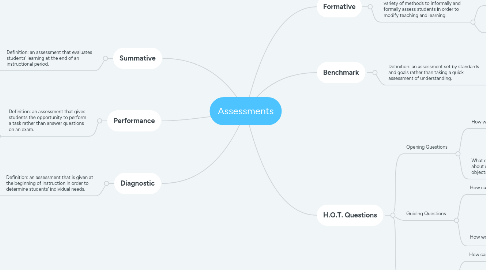
1. Summative
1.1. Definition: an assessment that evaluates students' learning at the end of an instructional period.
1.1.1. Example 1: an example of a summative assessment would be a end of year project.
1.1.2. Example2: an example of a summative assessment would be an end of unit exam.
2. Performance
2.1. Definition: an assessment that gives students the opportunity to perform a task rather than answer questions on an exam.
2.1.1. Example 1: an example of a performance assessment would be the creation of a piece of media about the content learned.
2.1.2. Example 2: an example of a performance assessment would be a presentation that teaches others about the content learned.
3. Diagnostic
3.1. Definition: an assessment that is given at the beginning of instruction in order to determine students' individual needs.
3.1.1. Example 1: an example of a diagnostic assessment would be a pretest.
3.1.2. Example 2: an example of a diagnostic assessment would be a quiz that gives teachers an idea of what to cover.
4. Formative
4.1. Definition: an assessment that uses a variety of methods to informally and formally assess students in order to modify teaching and learning.
4.1.1. Example 1: an example of a formal formative assessment would be a pretest or an in class quiz.
4.1.2. Example 2: an example of an informal formative assessment would be an observation of students working.
5. Benchmark
5.1. Definition: an assessment set by standards and goals rather than taking a quick assessment of understanding.
5.1.1. Example 1: an example of a benchmark would be Istation tests given at the end of the six weeks.
5.1.2. Example 2: an example of a benchmark would be a test given to students before a state standardized test.
6. H.O.T. Questions
6.1. Opening Questions
6.1.1. How would identify a 3D object?
6.1.2. What do you remember that is different about spheres compared to other 3D objects?
6.2. Guiding Questions
6.2.1. How can you identify a cube?
6.2.2. How would you describe a cone?
6.3. Closing Questions
6.3.1. How can you sort 3D objects?
6.3.2. How are 3D objects different from 2D shapes?
